David Simon's Blog, page 18
December 14, 2016
Shepherds of Greatness
This week in the devotional Advent Journeys we move to the fields outside Bethlehem. Have you ever wondered what it would be like to live as a shepherd? There is more to the life than just following sheep. Take a look at the devotions this week, you can explore for free if you are an Amazon Prime member. I think you will enjoy the adventures of the Shepherds. 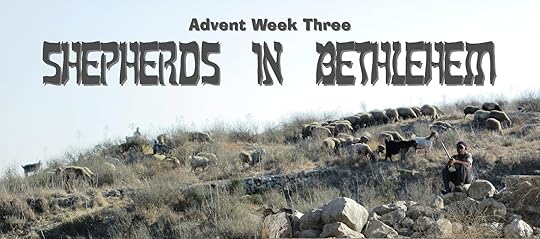 The Bible has a lot to say about shepherds. The first shepherd in the Bible (and we can assume the man who domesticated sheep) was Abel. His work, his heart of faith, and his offering pleased God. God’s love for Abel was seen by all (but there were not many people in the world at that time), and was displeasing to Abel’s brother Cain.
The Bible has a lot to say about shepherds. The first shepherd in the Bible (and we can assume the man who domesticated sheep) was Abel. His work, his heart of faith, and his offering pleased God. God’s love for Abel was seen by all (but there were not many people in the world at that time), and was displeasing to Abel’s brother Cain.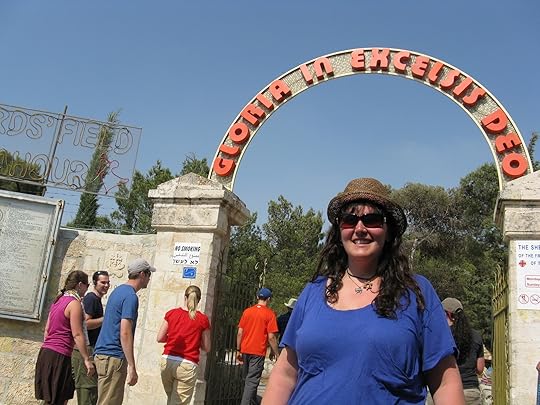 The Patriarchs: Abraham, Isaac, Jacob and Jacob’s sons were all shepherds. They developed large flocks, enjoyed great prosperity and developed quite a reputation as businessmen. Some of their neighbors were not too keen on their success. The Philistines stopped up their wells and attempted to get them to move, but God protected the Hebrew people.
The Patriarchs: Abraham, Isaac, Jacob and Jacob’s sons were all shepherds. They developed large flocks, enjoyed great prosperity and developed quite a reputation as businessmen. Some of their neighbors were not too keen on their success. The Philistines stopped up their wells and attempted to get them to move, but God protected the Hebrew people. 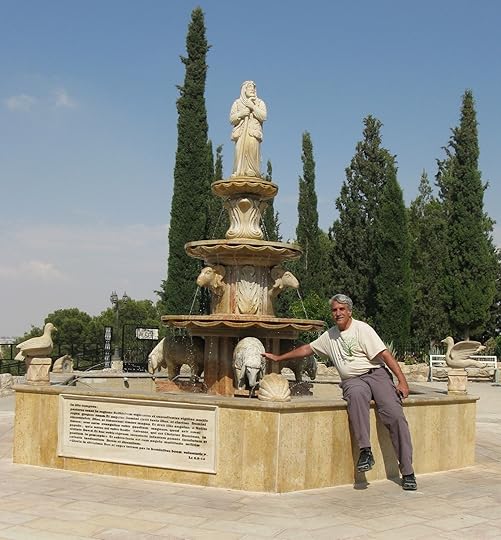 Moses took up shepherding at the age of forty after a tragedy made a move necessary to sof ha’olam smola (סוף העולם שמאלה). Moses possibly learned the basics of shepherding through leadership training in Egypt in the school of Pharaoh. On the back side of the desert Moses met his wife, saw a burning bush and received his call to lead the people of Israel out of Egypt. (Who ever said Shepherding is boring?)
Moses took up shepherding at the age of forty after a tragedy made a move necessary to sof ha’olam smola (סוף העולם שמאלה). Moses possibly learned the basics of shepherding through leadership training in Egypt in the school of Pharaoh. On the back side of the desert Moses met his wife, saw a burning bush and received his call to lead the people of Israel out of Egypt. (Who ever said Shepherding is boring?) In an opposite way a shepherd boy named David received training to become King of all Israel through his leadership of sheep. (I wonder if there is a similarity between dumb sheep and a nation full of people). David learned bravery through protecting his sheep. He learned to sing and compose music either through necessity because of the vastness and emptiness of the Judean wilderness or through the constant bleating of the sheep. The solitude of the desert also taught David to worship God.
In an opposite way a shepherd boy named David received training to become King of all Israel through his leadership of sheep. (I wonder if there is a similarity between dumb sheep and a nation full of people). David learned bravery through protecting his sheep. He learned to sing and compose music either through necessity because of the vastness and emptiness of the Judean wilderness or through the constant bleating of the sheep. The solitude of the desert also taught David to worship God.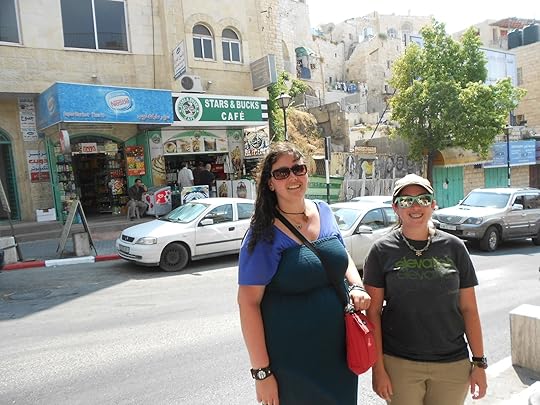 Shepherds are a unique group of people who carry a huge responsibility. This week we will join the shepherds as they live out their responsibilities and carry out their duties. Please, join the reading!
Shepherds are a unique group of people who carry a huge responsibility. This week we will join the shepherds as they live out their responsibilities and carry out their duties. Please, join the reading!
.
 The Bible has a lot to say about shepherds. The first shepherd in the Bible (and we can assume the man who domesticated sheep) was Abel. His work, his heart of faith, and his offering pleased God. God’s love for Abel was seen by all (but there were not many people in the world at that time), and was displeasing to Abel’s brother Cain.
The Bible has a lot to say about shepherds. The first shepherd in the Bible (and we can assume the man who domesticated sheep) was Abel. His work, his heart of faith, and his offering pleased God. God’s love for Abel was seen by all (but there were not many people in the world at that time), and was displeasing to Abel’s brother Cain. The Patriarchs: Abraham, Isaac, Jacob and Jacob’s sons were all shepherds. They developed large flocks, enjoyed great prosperity and developed quite a reputation as businessmen. Some of their neighbors were not too keen on their success. The Philistines stopped up their wells and attempted to get them to move, but God protected the Hebrew people.
The Patriarchs: Abraham, Isaac, Jacob and Jacob’s sons were all shepherds. They developed large flocks, enjoyed great prosperity and developed quite a reputation as businessmen. Some of their neighbors were not too keen on their success. The Philistines stopped up their wells and attempted to get them to move, but God protected the Hebrew people.  Moses took up shepherding at the age of forty after a tragedy made a move necessary to sof ha’olam smola (סוף העולם שמאלה). Moses possibly learned the basics of shepherding through leadership training in Egypt in the school of Pharaoh. On the back side of the desert Moses met his wife, saw a burning bush and received his call to lead the people of Israel out of Egypt. (Who ever said Shepherding is boring?)
Moses took up shepherding at the age of forty after a tragedy made a move necessary to sof ha’olam smola (סוף העולם שמאלה). Moses possibly learned the basics of shepherding through leadership training in Egypt in the school of Pharaoh. On the back side of the desert Moses met his wife, saw a burning bush and received his call to lead the people of Israel out of Egypt. (Who ever said Shepherding is boring?) In an opposite way a shepherd boy named David received training to become King of all Israel through his leadership of sheep. (I wonder if there is a similarity between dumb sheep and a nation full of people). David learned bravery through protecting his sheep. He learned to sing and compose music either through necessity because of the vastness and emptiness of the Judean wilderness or through the constant bleating of the sheep. The solitude of the desert also taught David to worship God.
In an opposite way a shepherd boy named David received training to become King of all Israel through his leadership of sheep. (I wonder if there is a similarity between dumb sheep and a nation full of people). David learned bravery through protecting his sheep. He learned to sing and compose music either through necessity because of the vastness and emptiness of the Judean wilderness or through the constant bleating of the sheep. The solitude of the desert also taught David to worship God. Shepherds are a unique group of people who carry a huge responsibility. This week we will join the shepherds as they live out their responsibilities and carry out their duties. Please, join the reading!
Shepherds are a unique group of people who carry a huge responsibility. This week we will join the shepherds as they live out their responsibilities and carry out their duties. Please, join the reading!.
Published on December 14, 2016 03:30
December 11, 2016
Christmas Sunday School
For many years I have served as a Minister of Education at churches in Wyoming, Kansas and North Carolina. As a Minister of Education I developed educational programs for all age levels from Preschool to Adults. I found and trained workers to staff these programs.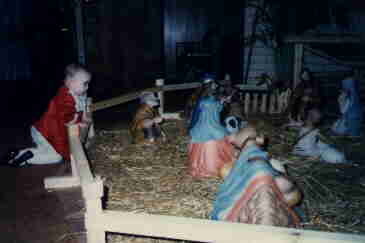 As a retired minister, I continue in my life’s work, but at a slower pace. One area where I continue to serve is in the Preschool. During my time of service I encouraged everyone to volunteer with Preschoolers once per month during the time of the worship service (we called this “extended session.”) As an example (because I must do as I said) I serve in the Kindergarten class (our Minister of Children finagled a way to get me to serve twice a month), and develop my lesson plans where the curriculum is weak.
As a retired minister, I continue in my life’s work, but at a slower pace. One area where I continue to serve is in the Preschool. During my time of service I encouraged everyone to volunteer with Preschoolers once per month during the time of the worship service (we called this “extended session.”) As an example (because I must do as I said) I serve in the Kindergarten class (our Minister of Children finagled a way to get me to serve twice a month), and develop my lesson plans where the curriculum is weak.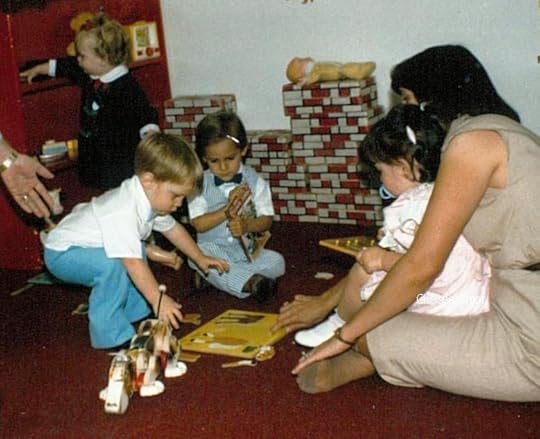 I have observed across the years that faith development in children is not automatic and a guide is required both at home and in church to to help children find the right path. I have shared in previous posts how I developed and carried out a lesson plan for the Christmas season each year with my family and in church. During the two weeks of teaching this month I drew upon my plan for Sunday’s lessons.
I have observed across the years that faith development in children is not automatic and a guide is required both at home and in church to to help children find the right path. I have shared in previous posts how I developed and carried out a lesson plan for the Christmas season each year with my family and in church. During the two weeks of teaching this month I drew upon my plan for Sunday’s lessons.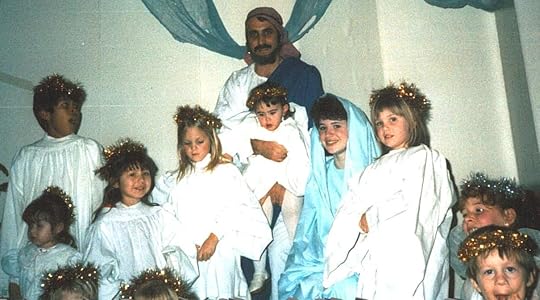 Last week’s lesson for children, and the journal in the devotional Advent Journeys, was about how the Angel Gabriel met Zechariah at the Altar of Incense in the Temple. My activity as I taught children was to have them lay down on a large sheet of paper with a crayon in each hand in order to draw angel wings snow-angel style. After the wings were drawn my helpers and I made an outline around the child’s body and let them color in the picture. As they colored, we taught the lesson.
Last week’s lesson for children, and the journal in the devotional Advent Journeys, was about how the Angel Gabriel met Zechariah at the Altar of Incense in the Temple. My activity as I taught children was to have them lay down on a large sheet of paper with a crayon in each hand in order to draw angel wings snow-angel style. After the wings were drawn my helpers and I made an outline around the child’s body and let them color in the picture. As they colored, we taught the lesson. This week’s lesson for children and the journal in the devotional Advent Journeys is about Joseph and Mary as they travel from Nazareth to Bethlehem and give birth to a Child. The birth of Jesus is the reason for the Christmas season, so it is with great joy that I look forward to teaching the children in our church tomorrow.As I thought about what to do (more than just crayons and paper), I decided to give them something that hopefully will last a lifetime: a nativity scene.
This week’s lesson for children and the journal in the devotional Advent Journeys is about Joseph and Mary as they travel from Nazareth to Bethlehem and give birth to a Child. The birth of Jesus is the reason for the Christmas season, so it is with great joy that I look forward to teaching the children in our church tomorrow.As I thought about what to do (more than just crayons and paper), I decided to give them something that hopefully will last a lifetime: a nativity scene. In our family we proudly display a nativity scene made of clay by my daughters and myself many years ago. Although rough and misshapen, the set contains many memories, and is hand made. The scene brings back memories of the class, my daughters' childhoods, Christmases of the past and the Christmas message. It is a keepsake which is the springboard to stories and sharing as people visit our home (and as I write this blog).
In our family we proudly display a nativity scene made of clay by my daughters and myself many years ago. Although rough and misshapen, the set contains many memories, and is hand made. The scene brings back memories of the class, my daughters' childhoods, Christmases of the past and the Christmas message. It is a keepsake which is the springboard to stories and sharing as people visit our home (and as I write this blog).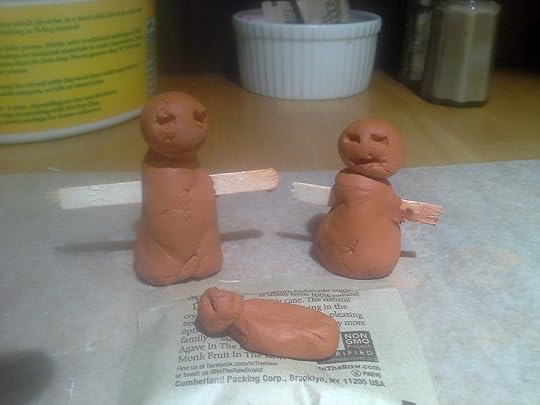 I decided to give the Kindergarten children in my class a gift. I bought air-dry clay and took it to breakfast this morning, where I practiced (and got it right the first time!) One pinch of clay rolled between my fingers to make the head. Three pinches of clay shaped like a bell to make the body. A coffee stirrer (I will use toothpicks in class) for the arms, and another pinch made the body and head for the baby. I cut small mangers out of pressed wood (looks like hay), and will put it in a box for a stable.
I decided to give the Kindergarten children in my class a gift. I bought air-dry clay and took it to breakfast this morning, where I practiced (and got it right the first time!) One pinch of clay rolled between my fingers to make the head. Three pinches of clay shaped like a bell to make the body. A coffee stirrer (I will use toothpicks in class) for the arms, and another pinch made the body and head for the baby. I cut small mangers out of pressed wood (looks like hay), and will put it in a box for a stable.
 As a retired minister, I continue in my life’s work, but at a slower pace. One area where I continue to serve is in the Preschool. During my time of service I encouraged everyone to volunteer with Preschoolers once per month during the time of the worship service (we called this “extended session.”) As an example (because I must do as I said) I serve in the Kindergarten class (our Minister of Children finagled a way to get me to serve twice a month), and develop my lesson plans where the curriculum is weak.
As a retired minister, I continue in my life’s work, but at a slower pace. One area where I continue to serve is in the Preschool. During my time of service I encouraged everyone to volunteer with Preschoolers once per month during the time of the worship service (we called this “extended session.”) As an example (because I must do as I said) I serve in the Kindergarten class (our Minister of Children finagled a way to get me to serve twice a month), and develop my lesson plans where the curriculum is weak. I have observed across the years that faith development in children is not automatic and a guide is required both at home and in church to to help children find the right path. I have shared in previous posts how I developed and carried out a lesson plan for the Christmas season each year with my family and in church. During the two weeks of teaching this month I drew upon my plan for Sunday’s lessons.
I have observed across the years that faith development in children is not automatic and a guide is required both at home and in church to to help children find the right path. I have shared in previous posts how I developed and carried out a lesson plan for the Christmas season each year with my family and in church. During the two weeks of teaching this month I drew upon my plan for Sunday’s lessons. Last week’s lesson for children, and the journal in the devotional Advent Journeys, was about how the Angel Gabriel met Zechariah at the Altar of Incense in the Temple. My activity as I taught children was to have them lay down on a large sheet of paper with a crayon in each hand in order to draw angel wings snow-angel style. After the wings were drawn my helpers and I made an outline around the child’s body and let them color in the picture. As they colored, we taught the lesson.
Last week’s lesson for children, and the journal in the devotional Advent Journeys, was about how the Angel Gabriel met Zechariah at the Altar of Incense in the Temple. My activity as I taught children was to have them lay down on a large sheet of paper with a crayon in each hand in order to draw angel wings snow-angel style. After the wings were drawn my helpers and I made an outline around the child’s body and let them color in the picture. As they colored, we taught the lesson. This week’s lesson for children and the journal in the devotional Advent Journeys is about Joseph and Mary as they travel from Nazareth to Bethlehem and give birth to a Child. The birth of Jesus is the reason for the Christmas season, so it is with great joy that I look forward to teaching the children in our church tomorrow.As I thought about what to do (more than just crayons and paper), I decided to give them something that hopefully will last a lifetime: a nativity scene.
This week’s lesson for children and the journal in the devotional Advent Journeys is about Joseph and Mary as they travel from Nazareth to Bethlehem and give birth to a Child. The birth of Jesus is the reason for the Christmas season, so it is with great joy that I look forward to teaching the children in our church tomorrow.As I thought about what to do (more than just crayons and paper), I decided to give them something that hopefully will last a lifetime: a nativity scene. In our family we proudly display a nativity scene made of clay by my daughters and myself many years ago. Although rough and misshapen, the set contains many memories, and is hand made. The scene brings back memories of the class, my daughters' childhoods, Christmases of the past and the Christmas message. It is a keepsake which is the springboard to stories and sharing as people visit our home (and as I write this blog).
In our family we proudly display a nativity scene made of clay by my daughters and myself many years ago. Although rough and misshapen, the set contains many memories, and is hand made. The scene brings back memories of the class, my daughters' childhoods, Christmases of the past and the Christmas message. It is a keepsake which is the springboard to stories and sharing as people visit our home (and as I write this blog). I decided to give the Kindergarten children in my class a gift. I bought air-dry clay and took it to breakfast this morning, where I practiced (and got it right the first time!) One pinch of clay rolled between my fingers to make the head. Three pinches of clay shaped like a bell to make the body. A coffee stirrer (I will use toothpicks in class) for the arms, and another pinch made the body and head for the baby. I cut small mangers out of pressed wood (looks like hay), and will put it in a box for a stable.
I decided to give the Kindergarten children in my class a gift. I bought air-dry clay and took it to breakfast this morning, where I practiced (and got it right the first time!) One pinch of clay rolled between my fingers to make the head. Three pinches of clay shaped like a bell to make the body. A coffee stirrer (I will use toothpicks in class) for the arms, and another pinch made the body and head for the baby. I cut small mangers out of pressed wood (looks like hay), and will put it in a box for a stable.
Published on December 11, 2016 06:02
December 6, 2016
Why?
This week’s journal in the devotional Advent Journeys seeks to speak the words of Joseph as he travels with Mary from Nazareth to Bethlehem. Joseph and Mary were unique individuals of character, and for this reason they were chosen by God to become parents who would be remembered and who would serve as examples for other parents across two thousand years of history.
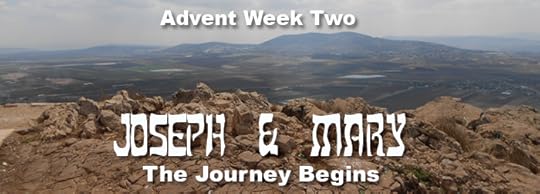 View from the Precipice near Nazareth Have you ever wondered why God chose this couple and how we can emulate their parenting methods with our own children?
View from the Precipice near Nazareth Have you ever wondered why God chose this couple and how we can emulate their parenting methods with our own children?
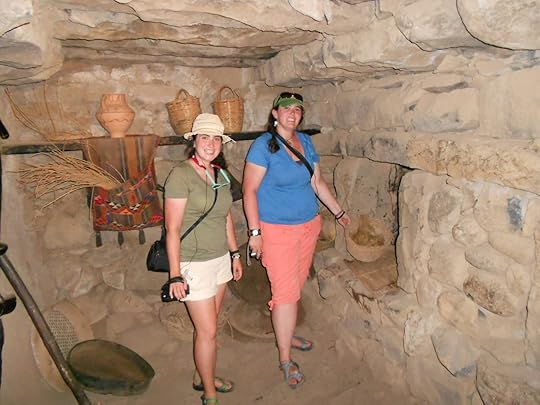 Kitchen at a home in KatzrinThe scripture teaches that Joseph and Mary were individuals with integrity. Each parent in their own way sought to honor God with all their hearts, minds and strength. (Deuteronomy 6:5) When Gabriel came to Mary in order to inform her that she was chosen to give birth to the one called “the Son of the Most High” (Luke 1:32), she responded by asking “How can this be since I am a virgin.” Mary wanted her faithfulness to be known by the angel, by her parents, by her community and by Joseph.
Kitchen at a home in KatzrinThe scripture teaches that Joseph and Mary were individuals with integrity. Each parent in their own way sought to honor God with all their hearts, minds and strength. (Deuteronomy 6:5) When Gabriel came to Mary in order to inform her that she was chosen to give birth to the one called “the Son of the Most High” (Luke 1:32), she responded by asking “How can this be since I am a virgin.” Mary wanted her faithfulness to be known by the angel, by her parents, by her community and by Joseph.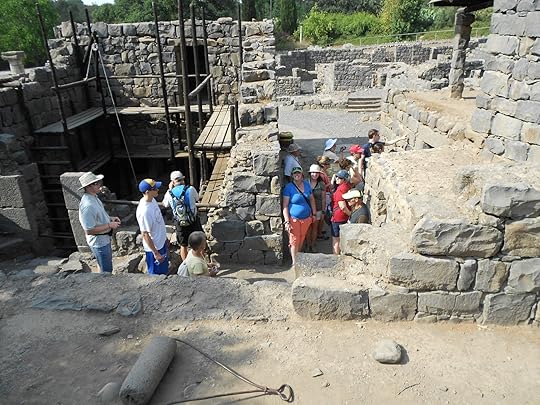 Village of Katzrin in the GalileeMatthew 1 tells of Joseph’s concern when he found out that Mary was pregnant. He loved her, but he knew his integrity would be compromised when the community came to know Mary was with child. Joseph sought a way to end the betrothal in an extremely private manner. As he prayed and sought God’s wisdom on the matter, Gabriel visited Joseph as he had visited Mary. The heavenly being assured Joseph that Mary had done nothing wrong. And the Angel asked Joseph to complete the marriage and to adopt the child.
Village of Katzrin in the GalileeMatthew 1 tells of Joseph’s concern when he found out that Mary was pregnant. He loved her, but he knew his integrity would be compromised when the community came to know Mary was with child. Joseph sought a way to end the betrothal in an extremely private manner. As he prayed and sought God’s wisdom on the matter, Gabriel visited Joseph as he had visited Mary. The heavenly being assured Joseph that Mary had done nothing wrong. And the Angel asked Joseph to complete the marriage and to adopt the child.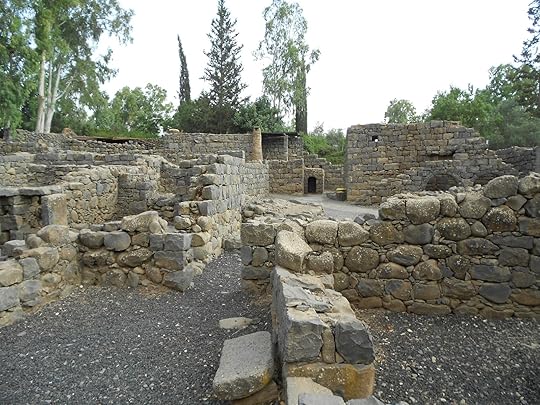 Village of Katzrin in the GalileeBoth parents had similar concerns and stepped out in faith to accept the child and God’s calling to become parents and teachers of a child who was well beyond them in intellect and righteousness.
Village of Katzrin in the GalileeBoth parents had similar concerns and stepped out in faith to accept the child and God’s calling to become parents and teachers of a child who was well beyond them in intellect and righteousness.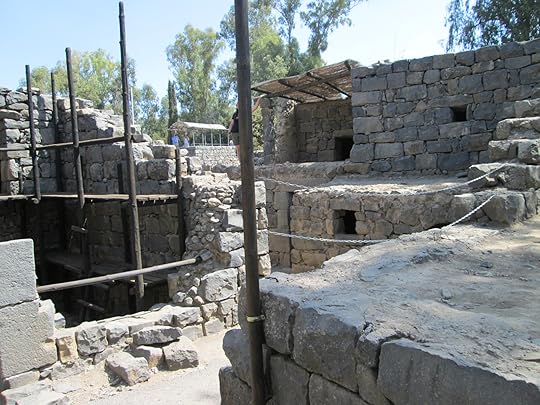 Scaffolding at KatzrinJoseph and Mary sought throughout the life of Jesus and of their other children (Matthew 13:55-56) to bring faith to their family. The holy parents taught their children the scripture at every opportunity. They stood as examples of faith through every trial (and there were many, such as the necessity of escape from Bethlehem and living as parents of faith in a foreign land). Joseph and Mary honored every Jewish tradition and honored the festivals with their family. Joseph taught Jesus the skills of his trade and Mary loved Jesus and lived her care for him to the day of his death and beyond.
Scaffolding at KatzrinJoseph and Mary sought throughout the life of Jesus and of their other children (Matthew 13:55-56) to bring faith to their family. The holy parents taught their children the scripture at every opportunity. They stood as examples of faith through every trial (and there were many, such as the necessity of escape from Bethlehem and living as parents of faith in a foreign land). Joseph and Mary honored every Jewish tradition and honored the festivals with their family. Joseph taught Jesus the skills of his trade and Mary loved Jesus and lived her care for him to the day of his death and beyond.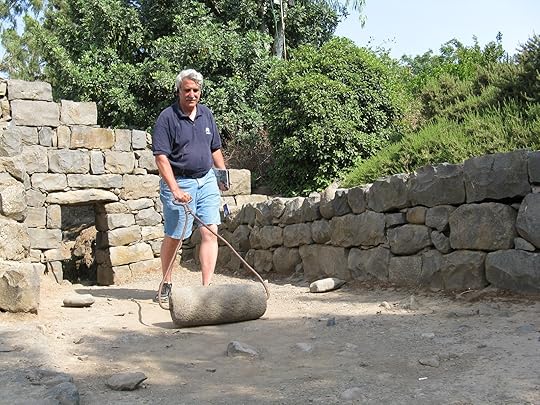 Packing down a roof in KatzrinJesus’ parents willingly took on any hardship and sought in every way to bring their children up in the faith. Today as parents we must do the same. We must honor the Christmas season with more than presents, we must honor God by giving our children our presence to tell real story of our faith. Parents show God’s love through proper placement of priorities.
Packing down a roof in KatzrinJesus’ parents willingly took on any hardship and sought in every way to bring their children up in the faith. Today as parents we must do the same. We must honor the Christmas season with more than presents, we must honor God by giving our children our presence to tell real story of our faith. Parents show God’s love through proper placement of priorities.
 View from the Precipice near Nazareth Have you ever wondered why God chose this couple and how we can emulate their parenting methods with our own children?
View from the Precipice near Nazareth Have you ever wondered why God chose this couple and how we can emulate their parenting methods with our own children? Kitchen at a home in KatzrinThe scripture teaches that Joseph and Mary were individuals with integrity. Each parent in their own way sought to honor God with all their hearts, minds and strength. (Deuteronomy 6:5) When Gabriel came to Mary in order to inform her that she was chosen to give birth to the one called “the Son of the Most High” (Luke 1:32), she responded by asking “How can this be since I am a virgin.” Mary wanted her faithfulness to be known by the angel, by her parents, by her community and by Joseph.
Kitchen at a home in KatzrinThe scripture teaches that Joseph and Mary were individuals with integrity. Each parent in their own way sought to honor God with all their hearts, minds and strength. (Deuteronomy 6:5) When Gabriel came to Mary in order to inform her that she was chosen to give birth to the one called “the Son of the Most High” (Luke 1:32), she responded by asking “How can this be since I am a virgin.” Mary wanted her faithfulness to be known by the angel, by her parents, by her community and by Joseph. Village of Katzrin in the GalileeMatthew 1 tells of Joseph’s concern when he found out that Mary was pregnant. He loved her, but he knew his integrity would be compromised when the community came to know Mary was with child. Joseph sought a way to end the betrothal in an extremely private manner. As he prayed and sought God’s wisdom on the matter, Gabriel visited Joseph as he had visited Mary. The heavenly being assured Joseph that Mary had done nothing wrong. And the Angel asked Joseph to complete the marriage and to adopt the child.
Village of Katzrin in the GalileeMatthew 1 tells of Joseph’s concern when he found out that Mary was pregnant. He loved her, but he knew his integrity would be compromised when the community came to know Mary was with child. Joseph sought a way to end the betrothal in an extremely private manner. As he prayed and sought God’s wisdom on the matter, Gabriel visited Joseph as he had visited Mary. The heavenly being assured Joseph that Mary had done nothing wrong. And the Angel asked Joseph to complete the marriage and to adopt the child. Village of Katzrin in the GalileeBoth parents had similar concerns and stepped out in faith to accept the child and God’s calling to become parents and teachers of a child who was well beyond them in intellect and righteousness.
Village of Katzrin in the GalileeBoth parents had similar concerns and stepped out in faith to accept the child and God’s calling to become parents and teachers of a child who was well beyond them in intellect and righteousness. Scaffolding at KatzrinJoseph and Mary sought throughout the life of Jesus and of their other children (Matthew 13:55-56) to bring faith to their family. The holy parents taught their children the scripture at every opportunity. They stood as examples of faith through every trial (and there were many, such as the necessity of escape from Bethlehem and living as parents of faith in a foreign land). Joseph and Mary honored every Jewish tradition and honored the festivals with their family. Joseph taught Jesus the skills of his trade and Mary loved Jesus and lived her care for him to the day of his death and beyond.
Scaffolding at KatzrinJoseph and Mary sought throughout the life of Jesus and of their other children (Matthew 13:55-56) to bring faith to their family. The holy parents taught their children the scripture at every opportunity. They stood as examples of faith through every trial (and there were many, such as the necessity of escape from Bethlehem and living as parents of faith in a foreign land). Joseph and Mary honored every Jewish tradition and honored the festivals with their family. Joseph taught Jesus the skills of his trade and Mary loved Jesus and lived her care for him to the day of his death and beyond. Packing down a roof in KatzrinJesus’ parents willingly took on any hardship and sought in every way to bring their children up in the faith. Today as parents we must do the same. We must honor the Christmas season with more than presents, we must honor God by giving our children our presence to tell real story of our faith. Parents show God’s love through proper placement of priorities.
Packing down a roof in KatzrinJesus’ parents willingly took on any hardship and sought in every way to bring their children up in the faith. Today as parents we must do the same. We must honor the Christmas season with more than presents, we must honor God by giving our children our presence to tell real story of our faith. Parents show God’s love through proper placement of priorities.
Published on December 06, 2016 12:20
December 4, 2016
Joseph the Builder
The Bible tells us Joseph, the father of Jesus was a carpenter (Mark 6:3). To most of us that means Joseph build things with wood, such as chairs, tables, homes, stables, and feeding troughs. This week as we read the book Advent Journeys we will come to know Joseph and Mary much better.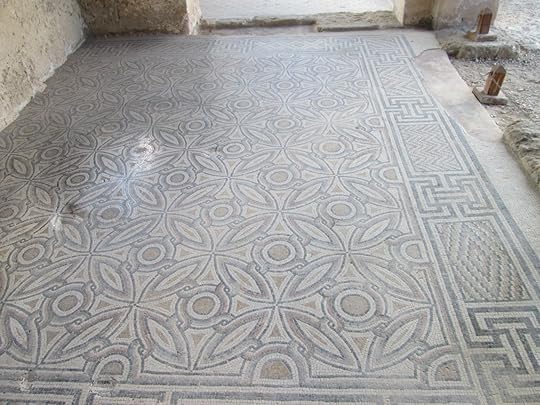 The Greek word for carpenter, τέκτων could also mean he was a craftsman or builder. After visiting Israel this definition seems much more reasonable, as wood is scarce in the land and most homes and buildings are made of stone. The term could also mean that Jesus’ father was a creator. We know that Jesus’ father in heaven was the real Creator (Genesis 1).
The Greek word for carpenter, τέκτων could also mean he was a craftsman or builder. After visiting Israel this definition seems much more reasonable, as wood is scarce in the land and most homes and buildings are made of stone. The term could also mean that Jesus’ father was a creator. We know that Jesus’ father in heaven was the real Creator (Genesis 1).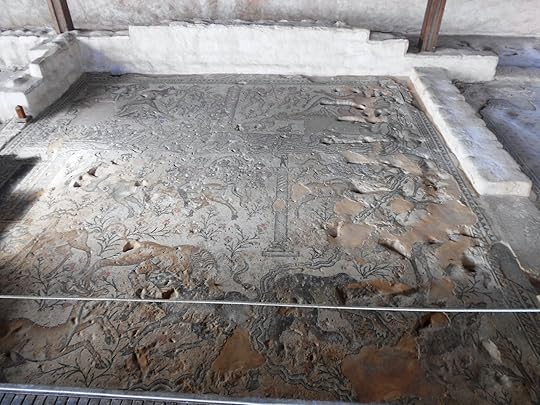 There has been a lot of discussion about what Joseph built. He and Mary both lived in the small Jewish town of Nazareth. Joseph could have repaired homes and objects in this small town. Certainly there were not a lot of new buildings or construction in Nazareth.
There has been a lot of discussion about what Joseph built. He and Mary both lived in the small Jewish town of Nazareth. Joseph could have repaired homes and objects in this small town. Certainly there were not a lot of new buildings or construction in Nazareth. 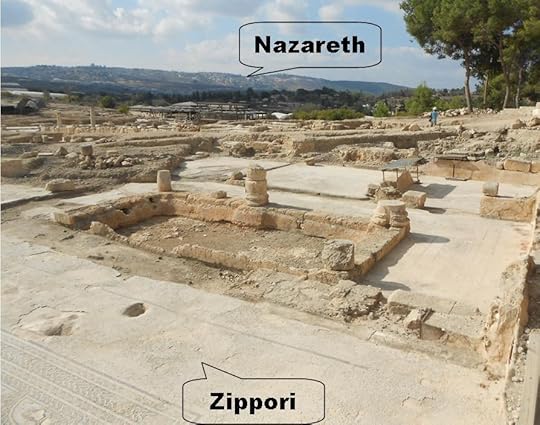 It is more probable that Joseph worked in the gentile city of Zippori, about three miles away (an easy 45 minute commute for someone used to walking). Zippori was an older town which was revitalized by Herod the Great as one of his building projects. Herod quartered an army at this location which was half way between the Mediterranean and the Sea of Galilee. The city was perched on top of a hill with excellent visibility and for that reason the Talmud tells us it was given it’s name which in Hebrew could mean a bird.
It is more probable that Joseph worked in the gentile city of Zippori, about three miles away (an easy 45 minute commute for someone used to walking). Zippori was an older town which was revitalized by Herod the Great as one of his building projects. Herod quartered an army at this location which was half way between the Mediterranean and the Sea of Galilee. The city was perched on top of a hill with excellent visibility and for that reason the Talmud tells us it was given it’s name which in Hebrew could mean a bird.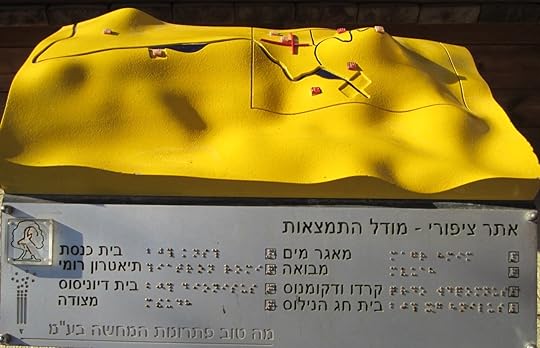 Joseph could have worked on minor projects, for there were homes and objects to create for the homes and businesses in the community. It is hard for me to think of the father of a great person like Jesus as the creator of menial things. I believe there are great objects which still exist today which were built by Joseph (which means “God adds”).
Joseph could have worked on minor projects, for there were homes and objects to create for the homes and businesses in the community. It is hard for me to think of the father of a great person like Jesus as the creator of menial things. I believe there are great objects which still exist today which were built by Joseph (which means “God adds”).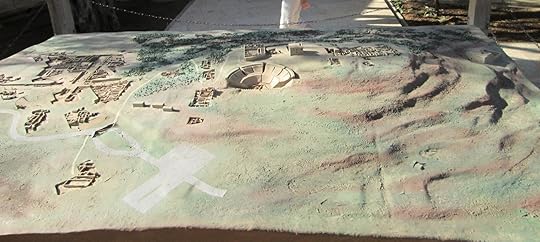 Joseph could have built the gigantic walls which were part of Zippori. Within this Roman city there are theaters, amphitheaters, hippodromes, palaces, government buildings and other huge projects. There were also fortified walls in order to provide protection for the troops. Some think Joseph was killed in a construction accident at an early age (before Mark 6:3 was written) because he does not appear during Jesus’ adult life. Accidental movement of massive rocks could certainly cause a person’s death.
Joseph could have built the gigantic walls which were part of Zippori. Within this Roman city there are theaters, amphitheaters, hippodromes, palaces, government buildings and other huge projects. There were also fortified walls in order to provide protection for the troops. Some think Joseph was killed in a construction accident at an early age (before Mark 6:3 was written) because he does not appear during Jesus’ adult life. Accidental movement of massive rocks could certainly cause a person’s death.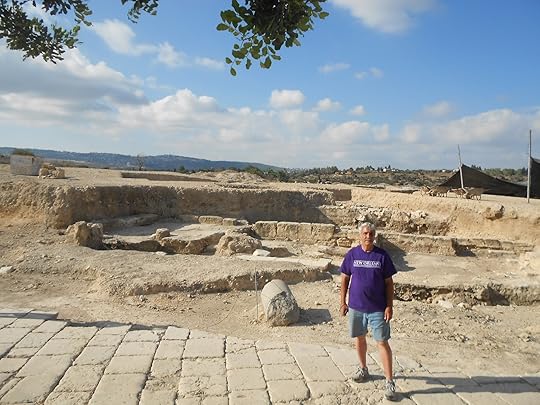 Joseph could have built roads which connected Zippori with Nazareth and places beyond, for the Romans were great road builders. The Roman roads helped make the world a place where the Gospel could be easily spread by traveling apostles and missionaries. The roads were made of huge blocks which were trimmed to be thin and flat.
Joseph could have built roads which connected Zippori with Nazareth and places beyond, for the Romans were great road builders. The Roman roads helped make the world a place where the Gospel could be easily spread by traveling apostles and missionaries. The roads were made of huge blocks which were trimmed to be thin and flat.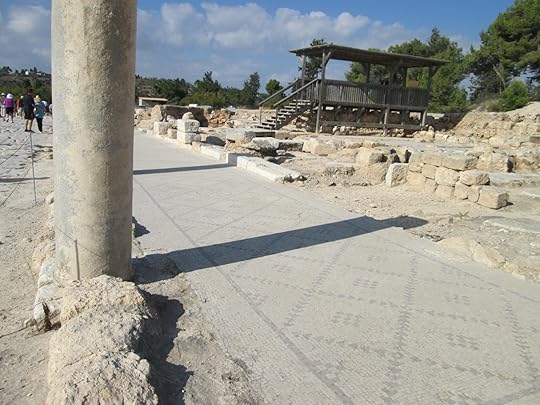 Zippori is known for it’s beautiful mosaics. Some people called this town the “Ornament of Galilee.” Mosaics are in many of the homes and are objects of great beauty. Mosaics are made of small square stones of different colors which create pictures. It could be that Joseph, and his son Jesus were creators of some of these Mosaics. One of the pictures is of such beauty it is called the Mona Lisa of Israel.
Zippori is known for it’s beautiful mosaics. Some people called this town the “Ornament of Galilee.” Mosaics are in many of the homes and are objects of great beauty. Mosaics are made of small square stones of different colors which create pictures. It could be that Joseph, and his son Jesus were creators of some of these Mosaics. One of the pictures is of such beauty it is called the Mona Lisa of Israel.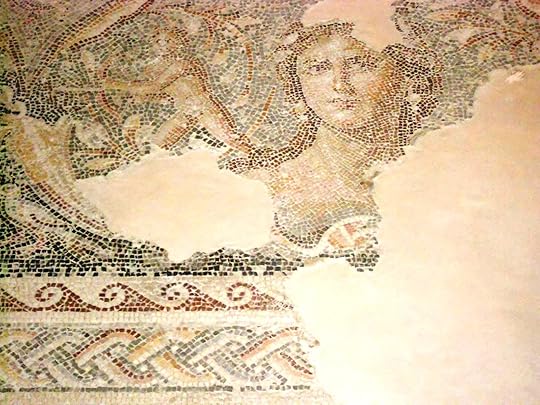
If you want to learn more about Israel or the mosaics of Zippori, or the travels of Joseph, I will be taking a group to Israel in June 2018. Watch for more details on my website (Israel Trip) www.KosherCopy.com
 The Greek word for carpenter, τέκτων could also mean he was a craftsman or builder. After visiting Israel this definition seems much more reasonable, as wood is scarce in the land and most homes and buildings are made of stone. The term could also mean that Jesus’ father was a creator. We know that Jesus’ father in heaven was the real Creator (Genesis 1).
The Greek word for carpenter, τέκτων could also mean he was a craftsman or builder. After visiting Israel this definition seems much more reasonable, as wood is scarce in the land and most homes and buildings are made of stone. The term could also mean that Jesus’ father was a creator. We know that Jesus’ father in heaven was the real Creator (Genesis 1). There has been a lot of discussion about what Joseph built. He and Mary both lived in the small Jewish town of Nazareth. Joseph could have repaired homes and objects in this small town. Certainly there were not a lot of new buildings or construction in Nazareth.
There has been a lot of discussion about what Joseph built. He and Mary both lived in the small Jewish town of Nazareth. Joseph could have repaired homes and objects in this small town. Certainly there were not a lot of new buildings or construction in Nazareth.  It is more probable that Joseph worked in the gentile city of Zippori, about three miles away (an easy 45 minute commute for someone used to walking). Zippori was an older town which was revitalized by Herod the Great as one of his building projects. Herod quartered an army at this location which was half way between the Mediterranean and the Sea of Galilee. The city was perched on top of a hill with excellent visibility and for that reason the Talmud tells us it was given it’s name which in Hebrew could mean a bird.
It is more probable that Joseph worked in the gentile city of Zippori, about three miles away (an easy 45 minute commute for someone used to walking). Zippori was an older town which was revitalized by Herod the Great as one of his building projects. Herod quartered an army at this location which was half way between the Mediterranean and the Sea of Galilee. The city was perched on top of a hill with excellent visibility and for that reason the Talmud tells us it was given it’s name which in Hebrew could mean a bird. Joseph could have worked on minor projects, for there were homes and objects to create for the homes and businesses in the community. It is hard for me to think of the father of a great person like Jesus as the creator of menial things. I believe there are great objects which still exist today which were built by Joseph (which means “God adds”).
Joseph could have worked on minor projects, for there were homes and objects to create for the homes and businesses in the community. It is hard for me to think of the father of a great person like Jesus as the creator of menial things. I believe there are great objects which still exist today which were built by Joseph (which means “God adds”). Joseph could have built the gigantic walls which were part of Zippori. Within this Roman city there are theaters, amphitheaters, hippodromes, palaces, government buildings and other huge projects. There were also fortified walls in order to provide protection for the troops. Some think Joseph was killed in a construction accident at an early age (before Mark 6:3 was written) because he does not appear during Jesus’ adult life. Accidental movement of massive rocks could certainly cause a person’s death.
Joseph could have built the gigantic walls which were part of Zippori. Within this Roman city there are theaters, amphitheaters, hippodromes, palaces, government buildings and other huge projects. There were also fortified walls in order to provide protection for the troops. Some think Joseph was killed in a construction accident at an early age (before Mark 6:3 was written) because he does not appear during Jesus’ adult life. Accidental movement of massive rocks could certainly cause a person’s death. Joseph could have built roads which connected Zippori with Nazareth and places beyond, for the Romans were great road builders. The Roman roads helped make the world a place where the Gospel could be easily spread by traveling apostles and missionaries. The roads were made of huge blocks which were trimmed to be thin and flat.
Joseph could have built roads which connected Zippori with Nazareth and places beyond, for the Romans were great road builders. The Roman roads helped make the world a place where the Gospel could be easily spread by traveling apostles and missionaries. The roads were made of huge blocks which were trimmed to be thin and flat. Zippori is known for it’s beautiful mosaics. Some people called this town the “Ornament of Galilee.” Mosaics are in many of the homes and are objects of great beauty. Mosaics are made of small square stones of different colors which create pictures. It could be that Joseph, and his son Jesus were creators of some of these Mosaics. One of the pictures is of such beauty it is called the Mona Lisa of Israel.
Zippori is known for it’s beautiful mosaics. Some people called this town the “Ornament of Galilee.” Mosaics are in many of the homes and are objects of great beauty. Mosaics are made of small square stones of different colors which create pictures. It could be that Joseph, and his son Jesus were creators of some of these Mosaics. One of the pictures is of such beauty it is called the Mona Lisa of Israel.
If you want to learn more about Israel or the mosaics of Zippori, or the travels of Joseph, I will be taking a group to Israel in June 2018. Watch for more details on my website (Israel Trip) www.KosherCopy.com
Published on December 04, 2016 12:24
December 1, 2016
The Temple’s Missing Item
The priests performed many tasks in the Temple. We attempt to relate these tasks as Zechariah might have perceived them in our book Advent Journeys. Zechariah served many roles during his twenty-five years of active service before retirement. In all, and even with even with the politics and toil which comes with a heavy work cycle, Zechariah never lost his zeal.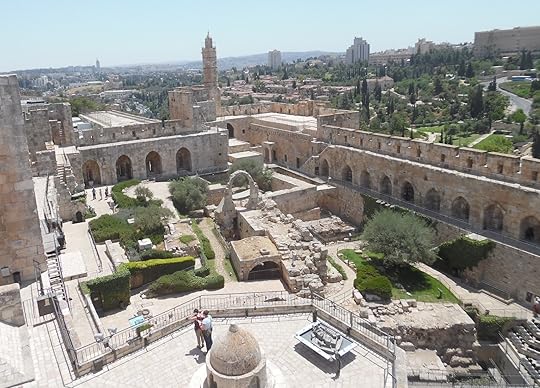 Looking int the Tower of David MuseumWith all of its magnificence (see the previous two blog posts) and all of its organization, the Temple of Zechariah lacked one thing. The most important piece of furniture, the throne of God, the box which was called the Ark of the Covenant, was missing. This box which held Israel’s treasures: the Ten Commandments, Aaron’s rod and a jar of manna, was sacred and the place where in history God had resided. The Ark of the Covenant had gone before Israel in battle and it was the first item brought to Jerusalem for Solomon’s Temple.
Looking int the Tower of David MuseumWith all of its magnificence (see the previous two blog posts) and all of its organization, the Temple of Zechariah lacked one thing. The most important piece of furniture, the throne of God, the box which was called the Ark of the Covenant, was missing. This box which held Israel’s treasures: the Ten Commandments, Aaron’s rod and a jar of manna, was sacred and the place where in history God had resided. The Ark of the Covenant had gone before Israel in battle and it was the first item brought to Jerusalem for Solomon’s Temple.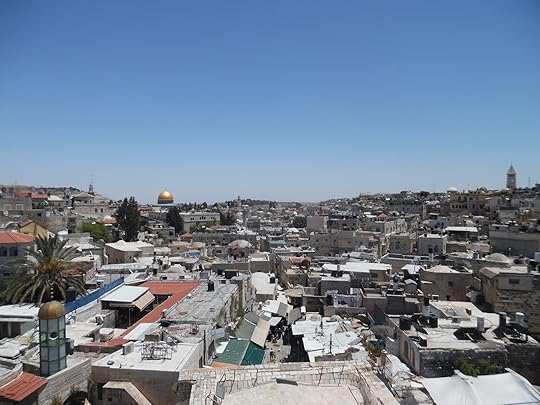 Jerusalem from the Ramparts WalkThe Ark of the Covenant with the Mercy Seat upon it was the place where the High Priest was to place the blood from Israel’s atonement offering each Yom Kippur. But in the days of Zechariah it was missing, and every priest was aware of this fact. One priest wrote: “After the Ark was taken away a stone remained there from the time of the early Prophets,” and it was called ‘Shetiyah’. It was higher than the ground by three fingerbreadths.”
Jerusalem from the Ramparts WalkThe Ark of the Covenant with the Mercy Seat upon it was the place where the High Priest was to place the blood from Israel’s atonement offering each Yom Kippur. But in the days of Zechariah it was missing, and every priest was aware of this fact. One priest wrote: “After the Ark was taken away a stone remained there from the time of the early Prophets,” and it was called ‘Shetiyah’. It was higher than the ground by three fingerbreadths.”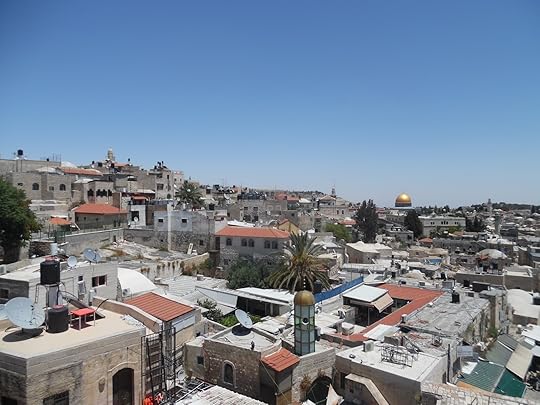 Temple Mount from Ramparts WalkAnother priest said: “Once when a priest was occupied he saw a block of pavement that was different from the rest. He went and told it to his fellow, but before he could make an end of the matter his life departed. So they knew assuredly that there the Ark lay hidden.”
Temple Mount from Ramparts WalkAnother priest said: “Once when a priest was occupied he saw a block of pavement that was different from the rest. He went and told it to his fellow, but before he could make an end of the matter his life departed. So they knew assuredly that there the Ark lay hidden.”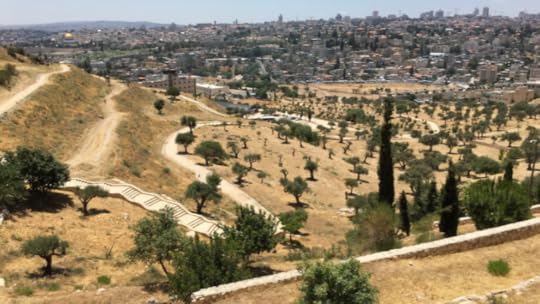 Jerusalem from Tabtznik ParkThe Holy of Holies remained important even without the Ark of the Covenant. The High Priest continued to go in every year on the Day of Atonement. He would sprinkle the blood on the place where the Ark of the Covenant had been placed before. To a priest of a lower level, like Zechariah, the Altar of Incense was the closest he could come to the Holy of Holies. It was at this place that the Angel met him and announced that he and Elizabeth would have a son.
Jerusalem from Tabtznik ParkThe Holy of Holies remained important even without the Ark of the Covenant. The High Priest continued to go in every year on the Day of Atonement. He would sprinkle the blood on the place where the Ark of the Covenant had been placed before. To a priest of a lower level, like Zechariah, the Altar of Incense was the closest he could come to the Holy of Holies. It was at this place that the Angel met him and announced that he and Elizabeth would have a son.
 Looking int the Tower of David MuseumWith all of its magnificence (see the previous two blog posts) and all of its organization, the Temple of Zechariah lacked one thing. The most important piece of furniture, the throne of God, the box which was called the Ark of the Covenant, was missing. This box which held Israel’s treasures: the Ten Commandments, Aaron’s rod and a jar of manna, was sacred and the place where in history God had resided. The Ark of the Covenant had gone before Israel in battle and it was the first item brought to Jerusalem for Solomon’s Temple.
Looking int the Tower of David MuseumWith all of its magnificence (see the previous two blog posts) and all of its organization, the Temple of Zechariah lacked one thing. The most important piece of furniture, the throne of God, the box which was called the Ark of the Covenant, was missing. This box which held Israel’s treasures: the Ten Commandments, Aaron’s rod and a jar of manna, was sacred and the place where in history God had resided. The Ark of the Covenant had gone before Israel in battle and it was the first item brought to Jerusalem for Solomon’s Temple. Jerusalem from the Ramparts WalkThe Ark of the Covenant with the Mercy Seat upon it was the place where the High Priest was to place the blood from Israel’s atonement offering each Yom Kippur. But in the days of Zechariah it was missing, and every priest was aware of this fact. One priest wrote: “After the Ark was taken away a stone remained there from the time of the early Prophets,” and it was called ‘Shetiyah’. It was higher than the ground by three fingerbreadths.”
Jerusalem from the Ramparts WalkThe Ark of the Covenant with the Mercy Seat upon it was the place where the High Priest was to place the blood from Israel’s atonement offering each Yom Kippur. But in the days of Zechariah it was missing, and every priest was aware of this fact. One priest wrote: “After the Ark was taken away a stone remained there from the time of the early Prophets,” and it was called ‘Shetiyah’. It was higher than the ground by three fingerbreadths.” Temple Mount from Ramparts WalkAnother priest said: “Once when a priest was occupied he saw a block of pavement that was different from the rest. He went and told it to his fellow, but before he could make an end of the matter his life departed. So they knew assuredly that there the Ark lay hidden.”
Temple Mount from Ramparts WalkAnother priest said: “Once when a priest was occupied he saw a block of pavement that was different from the rest. He went and told it to his fellow, but before he could make an end of the matter his life departed. So they knew assuredly that there the Ark lay hidden.” Jerusalem from Tabtznik ParkThe Holy of Holies remained important even without the Ark of the Covenant. The High Priest continued to go in every year on the Day of Atonement. He would sprinkle the blood on the place where the Ark of the Covenant had been placed before. To a priest of a lower level, like Zechariah, the Altar of Incense was the closest he could come to the Holy of Holies. It was at this place that the Angel met him and announced that he and Elizabeth would have a son.
Jerusalem from Tabtznik ParkThe Holy of Holies remained important even without the Ark of the Covenant. The High Priest continued to go in every year on the Day of Atonement. He would sprinkle the blood on the place where the Ark of the Covenant had been placed before. To a priest of a lower level, like Zechariah, the Altar of Incense was the closest he could come to the Holy of Holies. It was at this place that the Angel met him and announced that he and Elizabeth would have a son.
Published on December 01, 2016 03:30
November 29, 2016
Temple Days of Service
Zechariah the Priest looked forward to serving the Lord at the Temple each time the opportunity afforded itself, which was about five weeks per year. The journals in the book Advent Journeys attempts to share Zechariah’s passion and dedication for the Lord’s work.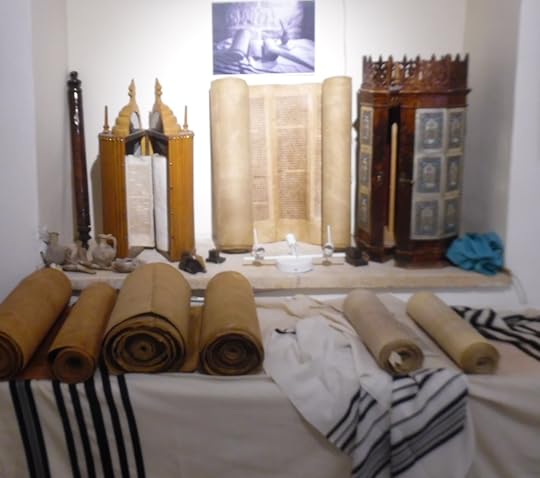 Scrolls inscribed by a SoferThe scripture relates to us as background the manner in which Israel’s priesthood is organized. At first, in the days of Moses, there were four divisions created in order to setup, tear down and carry the Tabernacle as it traveled across the wilderness. Once the Tabernacle became a permanent fixture in Shiloh, the priests were not needed for transportation. We can almost sense in 1 Samuel that common priests ceased to serve in the Tabernacle under Eli and his sons.
Scrolls inscribed by a SoferThe scripture relates to us as background the manner in which Israel’s priesthood is organized. At first, in the days of Moses, there were four divisions created in order to setup, tear down and carry the Tabernacle as it traveled across the wilderness. Once the Tabernacle became a permanent fixture in Shiloh, the priests were not needed for transportation. We can almost sense in 1 Samuel that common priests ceased to serve in the Tabernacle under Eli and his sons.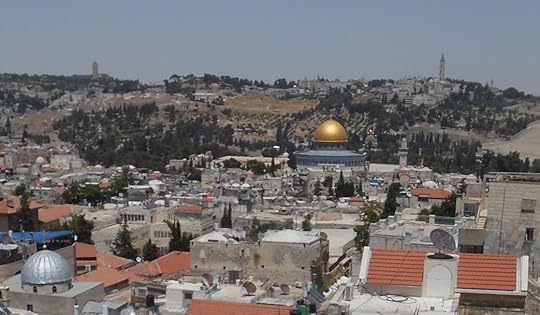 Temple Mount with Mount of Olives behindIn the establishment of the Temple in Jerusalem by King David, the orders of Priesthood were reestablished, and increased to twenty-four orders. The names of each of these orders can be seen in 1 Chronicles 24-26.
Temple Mount with Mount of Olives behindIn the establishment of the Temple in Jerusalem by King David, the orders of Priesthood were reestablished, and increased to twenty-four orders. The names of each of these orders can be seen in 1 Chronicles 24-26.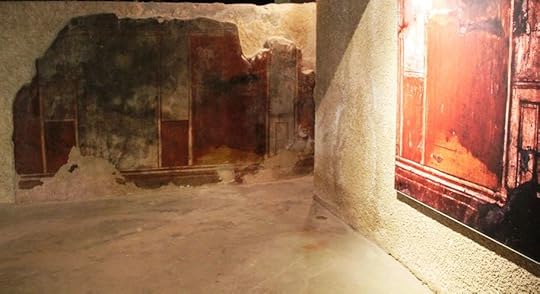 Home of one of the High PriestsKing David assigned some priests as gate-keepers: some to give the offering, some to cook meals and some for administration. David also organized Temple musicians, who shared their gift of music for generations.
Home of one of the High PriestsKing David assigned some priests as gate-keepers: some to give the offering, some to cook meals and some for administration. David also organized Temple musicians, who shared their gift of music for generations.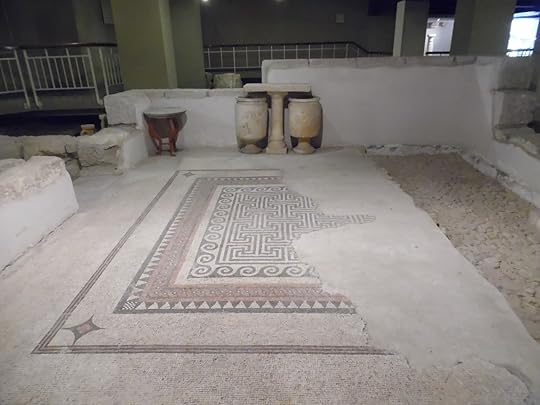 Home of one of the High PriestsAs the population of Israel grew, so did the priesthood. With the establishment of a permanent structure, all priests were not needed every week, so a system of rotation called Mishmarot and Ma’amadot was set up. All priests would serve during the three harvest festivals, and then in rotation once every twenty-four weeks. The scripture tells us Zechariah was a Priest of the order of Abijah.
Home of one of the High PriestsAs the population of Israel grew, so did the priesthood. With the establishment of a permanent structure, all priests were not needed every week, so a system of rotation called Mishmarot and Ma’amadot was set up. All priests would serve during the three harvest festivals, and then in rotation once every twenty-four weeks. The scripture tells us Zechariah was a Priest of the order of Abijah.
 Scrolls inscribed by a SoferThe scripture relates to us as background the manner in which Israel’s priesthood is organized. At first, in the days of Moses, there were four divisions created in order to setup, tear down and carry the Tabernacle as it traveled across the wilderness. Once the Tabernacle became a permanent fixture in Shiloh, the priests were not needed for transportation. We can almost sense in 1 Samuel that common priests ceased to serve in the Tabernacle under Eli and his sons.
Scrolls inscribed by a SoferThe scripture relates to us as background the manner in which Israel’s priesthood is organized. At first, in the days of Moses, there were four divisions created in order to setup, tear down and carry the Tabernacle as it traveled across the wilderness. Once the Tabernacle became a permanent fixture in Shiloh, the priests were not needed for transportation. We can almost sense in 1 Samuel that common priests ceased to serve in the Tabernacle under Eli and his sons. Temple Mount with Mount of Olives behindIn the establishment of the Temple in Jerusalem by King David, the orders of Priesthood were reestablished, and increased to twenty-four orders. The names of each of these orders can be seen in 1 Chronicles 24-26.
Temple Mount with Mount of Olives behindIn the establishment of the Temple in Jerusalem by King David, the orders of Priesthood were reestablished, and increased to twenty-four orders. The names of each of these orders can be seen in 1 Chronicles 24-26. Home of one of the High PriestsKing David assigned some priests as gate-keepers: some to give the offering, some to cook meals and some for administration. David also organized Temple musicians, who shared their gift of music for generations.
Home of one of the High PriestsKing David assigned some priests as gate-keepers: some to give the offering, some to cook meals and some for administration. David also organized Temple musicians, who shared their gift of music for generations. Home of one of the High PriestsAs the population of Israel grew, so did the priesthood. With the establishment of a permanent structure, all priests were not needed every week, so a system of rotation called Mishmarot and Ma’amadot was set up. All priests would serve during the three harvest festivals, and then in rotation once every twenty-four weeks. The scripture tells us Zechariah was a Priest of the order of Abijah.
Home of one of the High PriestsAs the population of Israel grew, so did the priesthood. With the establishment of a permanent structure, all priests were not needed every week, so a system of rotation called Mishmarot and Ma’amadot was set up. All priests would serve during the three harvest festivals, and then in rotation once every twenty-four weeks. The scripture tells us Zechariah was a Priest of the order of Abijah.
Published on November 29, 2016 03:30
November 27, 2016
Zechariah in the Temple
The Temple of the first century is a fascinating place! The Temple itself was the center of activity, serving thousands of people each day. The plaza around the Temple was a meeting place of pilgrims who came from long distances to bring an offering and merchants who were selling the offering to the pilgrims. It was a place of contention for Sadducees, Pharisees, Essenes, Herodians, Zealots, and others who came to argue politics and religion. It was also a place for locals, who came to watch the commotion.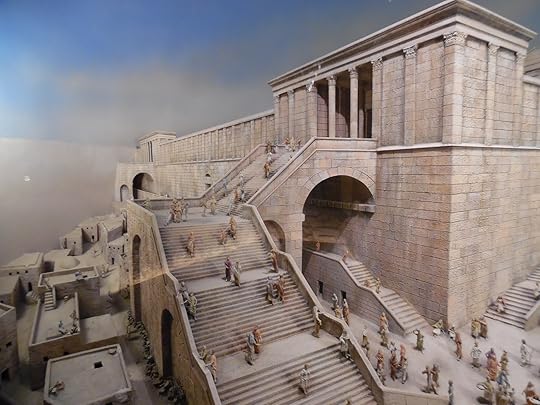 The Robinson Arch entrance to the TempleThe Temple itself was a modern building, having been totally reconstructed by King Herod the Great. The magnificent Sanctuary was a hundred cubits square and a hundred cubits in height. The Temple Mount measured five hundred cubits by five hundred cubits. Its largest open space was to the south, the next largest to the east, the third largest to the north, and its smallest was to the west. The King had erected the monstrous edifice in order to claim bragging rights (it was a third larger than Solomon’s Temple) and hopefully to appease the Jews who could be a rebellious and obstinate people.
The Robinson Arch entrance to the TempleThe Temple itself was a modern building, having been totally reconstructed by King Herod the Great. The magnificent Sanctuary was a hundred cubits square and a hundred cubits in height. The Temple Mount measured five hundred cubits by five hundred cubits. Its largest open space was to the south, the next largest to the east, the third largest to the north, and its smallest was to the west. The King had erected the monstrous edifice in order to claim bragging rights (it was a third larger than Solomon’s Temple) and hopefully to appease the Jews who could be a rebellious and obstinate people.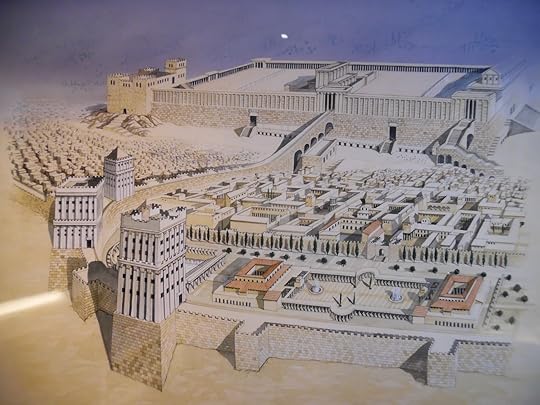 Jerusalem at the time of JesusZechariah, the father of John the Baptist and the subject of this week’s readings in Advent Journeys, was of the generation of priests who had served in both the old Temple and the new facility. The priests enjoyed the spaciousness and modernalities of the new superstructure. The priests enjoyed the tables of marble upon which the sacrifices were prepared. They talked about parading down the colonnades on the east and west of the Temple itself early in the morning. They bragged about the wooden device which Ben Katin had made for the laver. They knew that no expense had been spared in the construction of the new Temple.
Jerusalem at the time of JesusZechariah, the father of John the Baptist and the subject of this week’s readings in Advent Journeys, was of the generation of priests who had served in both the old Temple and the new facility. The priests enjoyed the spaciousness and modernalities of the new superstructure. The priests enjoyed the tables of marble upon which the sacrifices were prepared. They talked about parading down the colonnades on the east and west of the Temple itself early in the morning. They bragged about the wooden device which Ben Katin had made for the laver. They knew that no expense had been spared in the construction of the new Temple.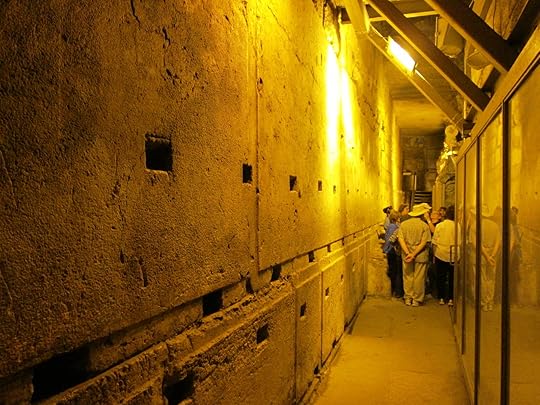 Underground tour shows large stones of Temple MountThe magnificence and wonder of the construction can still be seen on the underground tour of the Western Walls. If you would like to see and touch the stone structure, please accept this as an invitation to join our family on a June 2018 tour of the Holy Land. More information can be found on our website.
Underground tour shows large stones of Temple MountThe magnificence and wonder of the construction can still be seen on the underground tour of the Western Walls. If you would like to see and touch the stone structure, please accept this as an invitation to join our family on a June 2018 tour of the Holy Land. More information can be found on our website.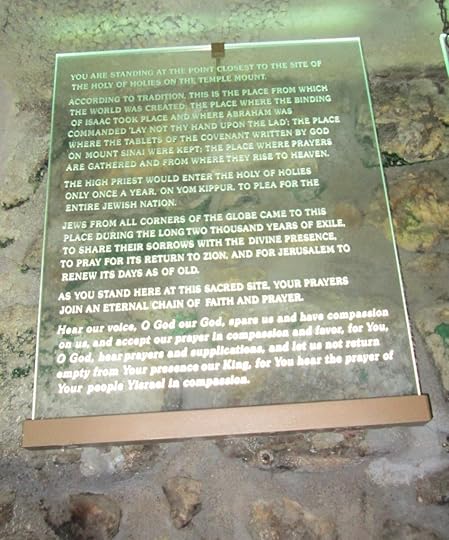 Marker for location closest to Holy of HoliesAround the Temple were service buildings constructed to facilitate every portion of the work. There were six chambers in the Temple Court, three to the north and three to the south. Those to the north were the Salt Chamber, the Parwah Chamber, and the Rinsing Chamber. To the south were the Wood Chamber, the Golah Chamber, and the Chamber of Hewn Stone. There were seven gates to the Temple Court: three to the north, three to the south, and one to the east. Those to the south were the Kindling Gate, next to it the Gate of the Firstlings, and the third was the Water Gate. The one to the east was the Nicanor Gate, beside which were two Chambers, one to the right and one to the left; the one was the Chamber of Phineas, the keeper of the vestments, and the other the chamber of them that made the Baken Cakes.
Marker for location closest to Holy of HoliesAround the Temple were service buildings constructed to facilitate every portion of the work. There were six chambers in the Temple Court, three to the north and three to the south. Those to the north were the Salt Chamber, the Parwah Chamber, and the Rinsing Chamber. To the south were the Wood Chamber, the Golah Chamber, and the Chamber of Hewn Stone. There were seven gates to the Temple Court: three to the north, three to the south, and one to the east. Those to the south were the Kindling Gate, next to it the Gate of the Firstlings, and the third was the Water Gate. The one to the east was the Nicanor Gate, beside which were two Chambers, one to the right and one to the left; the one was the Chamber of Phineas, the keeper of the vestments, and the other the chamber of them that made the Baken Cakes.
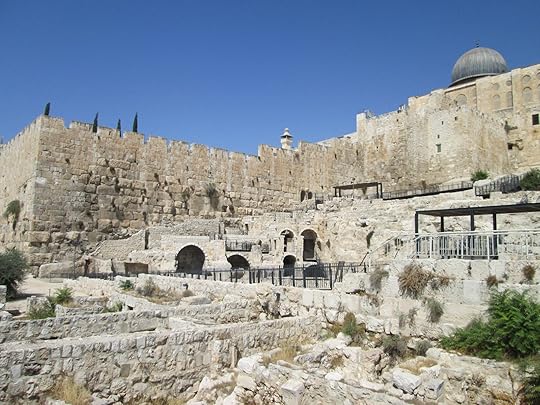 Archaeological finds south of original Temple MountThe new Temple was in every way a stark contrast to the Temple built under the leadership of Ezra, Joshua, Zerubbabel and Nehemiah. Zechariah approached the Temple with a sense of awe each week of his service.
Archaeological finds south of original Temple MountThe new Temple was in every way a stark contrast to the Temple built under the leadership of Ezra, Joshua, Zerubbabel and Nehemiah. Zechariah approached the Temple with a sense of awe each week of his service.
 The Robinson Arch entrance to the TempleThe Temple itself was a modern building, having been totally reconstructed by King Herod the Great. The magnificent Sanctuary was a hundred cubits square and a hundred cubits in height. The Temple Mount measured five hundred cubits by five hundred cubits. Its largest open space was to the south, the next largest to the east, the third largest to the north, and its smallest was to the west. The King had erected the monstrous edifice in order to claim bragging rights (it was a third larger than Solomon’s Temple) and hopefully to appease the Jews who could be a rebellious and obstinate people.
The Robinson Arch entrance to the TempleThe Temple itself was a modern building, having been totally reconstructed by King Herod the Great. The magnificent Sanctuary was a hundred cubits square and a hundred cubits in height. The Temple Mount measured five hundred cubits by five hundred cubits. Its largest open space was to the south, the next largest to the east, the third largest to the north, and its smallest was to the west. The King had erected the monstrous edifice in order to claim bragging rights (it was a third larger than Solomon’s Temple) and hopefully to appease the Jews who could be a rebellious and obstinate people. Jerusalem at the time of JesusZechariah, the father of John the Baptist and the subject of this week’s readings in Advent Journeys, was of the generation of priests who had served in both the old Temple and the new facility. The priests enjoyed the spaciousness and modernalities of the new superstructure. The priests enjoyed the tables of marble upon which the sacrifices were prepared. They talked about parading down the colonnades on the east and west of the Temple itself early in the morning. They bragged about the wooden device which Ben Katin had made for the laver. They knew that no expense had been spared in the construction of the new Temple.
Jerusalem at the time of JesusZechariah, the father of John the Baptist and the subject of this week’s readings in Advent Journeys, was of the generation of priests who had served in both the old Temple and the new facility. The priests enjoyed the spaciousness and modernalities of the new superstructure. The priests enjoyed the tables of marble upon which the sacrifices were prepared. They talked about parading down the colonnades on the east and west of the Temple itself early in the morning. They bragged about the wooden device which Ben Katin had made for the laver. They knew that no expense had been spared in the construction of the new Temple. Underground tour shows large stones of Temple MountThe magnificence and wonder of the construction can still be seen on the underground tour of the Western Walls. If you would like to see and touch the stone structure, please accept this as an invitation to join our family on a June 2018 tour of the Holy Land. More information can be found on our website.
Underground tour shows large stones of Temple MountThe magnificence and wonder of the construction can still be seen on the underground tour of the Western Walls. If you would like to see and touch the stone structure, please accept this as an invitation to join our family on a June 2018 tour of the Holy Land. More information can be found on our website. Marker for location closest to Holy of HoliesAround the Temple were service buildings constructed to facilitate every portion of the work. There were six chambers in the Temple Court, three to the north and three to the south. Those to the north were the Salt Chamber, the Parwah Chamber, and the Rinsing Chamber. To the south were the Wood Chamber, the Golah Chamber, and the Chamber of Hewn Stone. There were seven gates to the Temple Court: three to the north, three to the south, and one to the east. Those to the south were the Kindling Gate, next to it the Gate of the Firstlings, and the third was the Water Gate. The one to the east was the Nicanor Gate, beside which were two Chambers, one to the right and one to the left; the one was the Chamber of Phineas, the keeper of the vestments, and the other the chamber of them that made the Baken Cakes.
Marker for location closest to Holy of HoliesAround the Temple were service buildings constructed to facilitate every portion of the work. There were six chambers in the Temple Court, three to the north and three to the south. Those to the north were the Salt Chamber, the Parwah Chamber, and the Rinsing Chamber. To the south were the Wood Chamber, the Golah Chamber, and the Chamber of Hewn Stone. There were seven gates to the Temple Court: three to the north, three to the south, and one to the east. Those to the south were the Kindling Gate, next to it the Gate of the Firstlings, and the third was the Water Gate. The one to the east was the Nicanor Gate, beside which were two Chambers, one to the right and one to the left; the one was the Chamber of Phineas, the keeper of the vestments, and the other the chamber of them that made the Baken Cakes. Archaeological finds south of original Temple MountThe new Temple was in every way a stark contrast to the Temple built under the leadership of Ezra, Joshua, Zerubbabel and Nehemiah. Zechariah approached the Temple with a sense of awe each week of his service.
Archaeological finds south of original Temple MountThe new Temple was in every way a stark contrast to the Temple built under the leadership of Ezra, Joshua, Zerubbabel and Nehemiah. Zechariah approached the Temple with a sense of awe each week of his service.
Published on November 27, 2016 03:30
November 26, 2016
Elizabeth at Home
In writing the words of Advent Journeys I came to thoroughly enjoy taking walks with the Biblical characters themselves. One of the couples I enjoyed visiting with the most was Elizabeth and Zechariah, the parents of John the Baptist. By tradition this couple lives in Beth Hakkerem (then Jer. 6:1; Neh. 3:14), or Ein Karem (today).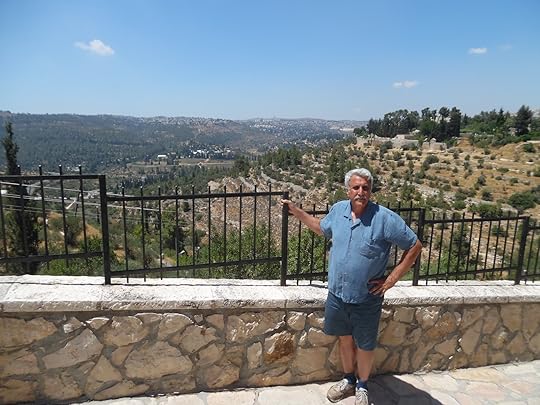 Over this wall we see the valley through which Joseph traveledI first met this couple on Joseph’s trip (which occurs in the book on Week 2, but I wrote it first) as Mary came to visit her cousin when she finds out she is pregnant. As Joseph and Mary travel to Bethlehem, they visit Zechariah and Elizabeth along the way. Ein Karem is one of the Levitical cities located about five miles from Jerusalem.
Over this wall we see the valley through which Joseph traveledI first met this couple on Joseph’s trip (which occurs in the book on Week 2, but I wrote it first) as Mary came to visit her cousin when she finds out she is pregnant. As Joseph and Mary travel to Bethlehem, they visit Zechariah and Elizabeth along the way. Ein Karem is one of the Levitical cities located about five miles from Jerusalem.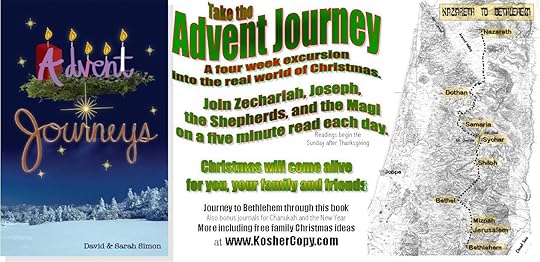 The map of Joseph & Mary's route on rightEin Karem is on the west side of a mountain which separates it from Jerusalem proper. In order to get there from Jerusalem on our travels in Israel, we took the light rail to the top of Mt. Herzl, and then transferred to a bus which took us down a long descent into the village. From the village we could see the ancient travel paths through a valley from the north and a valley which extended west, then south and finally to the east on the other side of the mountain. The terrain around the village is mountainous.
The map of Joseph & Mary's route on rightEin Karem is on the west side of a mountain which separates it from Jerusalem proper. In order to get there from Jerusalem on our travels in Israel, we took the light rail to the top of Mt. Herzl, and then transferred to a bus which took us down a long descent into the village. From the village we could see the ancient travel paths through a valley from the north and a valley which extended west, then south and finally to the east on the other side of the mountain. The terrain around the village is mountainous.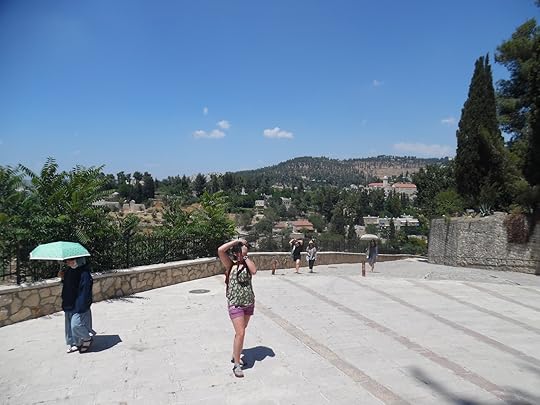 In front of Church of the Visitation in Ein KaremThe village today is small (considering its location as a suburb of Jerusalem), with a population of about 2,000 people. In the days of Zechariah and Elizabeth, there would have been less than 200 people.Today it is said Ein Karem hosts about three million visitors per year. They come to see the village where John the Baptist grew up. They visit the spring where Elizabeth came out to greet Mary. They enter the Church of the Visitation, the Church of St. John the Baptist, the monastery of Les Soeurs de Notre-Dam de Sion, and the Moscobia Convent. The churches are very beautiful, and the small village descending from the spring into the valley speaks of the rural setting of John the Baptist’s nativity.
In front of Church of the Visitation in Ein KaremThe village today is small (considering its location as a suburb of Jerusalem), with a population of about 2,000 people. In the days of Zechariah and Elizabeth, there would have been less than 200 people.Today it is said Ein Karem hosts about three million visitors per year. They come to see the village where John the Baptist grew up. They visit the spring where Elizabeth came out to greet Mary. They enter the Church of the Visitation, the Church of St. John the Baptist, the monastery of Les Soeurs de Notre-Dam de Sion, and the Moscobia Convent. The churches are very beautiful, and the small village descending from the spring into the valley speaks of the rural setting of John the Baptist’s nativity.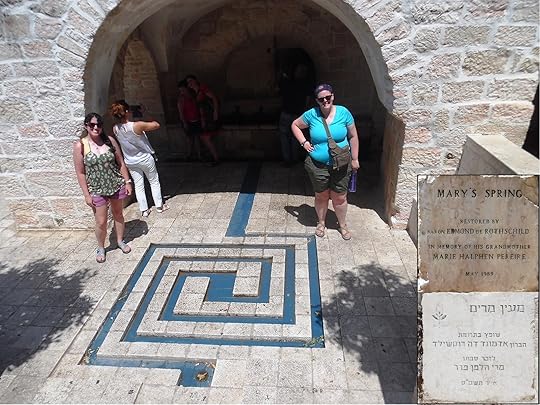 Mary's Well in Ein KaremAfter ascending to the Church of the Visitation we stopped in a grocery to buy soft drinks and watch the pilgrims parading through the streets from one church to another. But through the crowds we could enjoy the quietness of what this village was in the days of Zechariah and Elizabeth, Mary and Joseph, and the two boys who every once in a while played on the dirt roads and in the spring.
Mary's Well in Ein KaremAfter ascending to the Church of the Visitation we stopped in a grocery to buy soft drinks and watch the pilgrims parading through the streets from one church to another. But through the crowds we could enjoy the quietness of what this village was in the days of Zechariah and Elizabeth, Mary and Joseph, and the two boys who every once in a while played on the dirt roads and in the spring.
 Over this wall we see the valley through which Joseph traveledI first met this couple on Joseph’s trip (which occurs in the book on Week 2, but I wrote it first) as Mary came to visit her cousin when she finds out she is pregnant. As Joseph and Mary travel to Bethlehem, they visit Zechariah and Elizabeth along the way. Ein Karem is one of the Levitical cities located about five miles from Jerusalem.
Over this wall we see the valley through which Joseph traveledI first met this couple on Joseph’s trip (which occurs in the book on Week 2, but I wrote it first) as Mary came to visit her cousin when she finds out she is pregnant. As Joseph and Mary travel to Bethlehem, they visit Zechariah and Elizabeth along the way. Ein Karem is one of the Levitical cities located about five miles from Jerusalem. The map of Joseph & Mary's route on rightEin Karem is on the west side of a mountain which separates it from Jerusalem proper. In order to get there from Jerusalem on our travels in Israel, we took the light rail to the top of Mt. Herzl, and then transferred to a bus which took us down a long descent into the village. From the village we could see the ancient travel paths through a valley from the north and a valley which extended west, then south and finally to the east on the other side of the mountain. The terrain around the village is mountainous.
The map of Joseph & Mary's route on rightEin Karem is on the west side of a mountain which separates it from Jerusalem proper. In order to get there from Jerusalem on our travels in Israel, we took the light rail to the top of Mt. Herzl, and then transferred to a bus which took us down a long descent into the village. From the village we could see the ancient travel paths through a valley from the north and a valley which extended west, then south and finally to the east on the other side of the mountain. The terrain around the village is mountainous. In front of Church of the Visitation in Ein KaremThe village today is small (considering its location as a suburb of Jerusalem), with a population of about 2,000 people. In the days of Zechariah and Elizabeth, there would have been less than 200 people.Today it is said Ein Karem hosts about three million visitors per year. They come to see the village where John the Baptist grew up. They visit the spring where Elizabeth came out to greet Mary. They enter the Church of the Visitation, the Church of St. John the Baptist, the monastery of Les Soeurs de Notre-Dam de Sion, and the Moscobia Convent. The churches are very beautiful, and the small village descending from the spring into the valley speaks of the rural setting of John the Baptist’s nativity.
In front of Church of the Visitation in Ein KaremThe village today is small (considering its location as a suburb of Jerusalem), with a population of about 2,000 people. In the days of Zechariah and Elizabeth, there would have been less than 200 people.Today it is said Ein Karem hosts about three million visitors per year. They come to see the village where John the Baptist grew up. They visit the spring where Elizabeth came out to greet Mary. They enter the Church of the Visitation, the Church of St. John the Baptist, the monastery of Les Soeurs de Notre-Dam de Sion, and the Moscobia Convent. The churches are very beautiful, and the small village descending from the spring into the valley speaks of the rural setting of John the Baptist’s nativity. Mary's Well in Ein KaremAfter ascending to the Church of the Visitation we stopped in a grocery to buy soft drinks and watch the pilgrims parading through the streets from one church to another. But through the crowds we could enjoy the quietness of what this village was in the days of Zechariah and Elizabeth, Mary and Joseph, and the two boys who every once in a while played on the dirt roads and in the spring.
Mary's Well in Ein KaremAfter ascending to the Church of the Visitation we stopped in a grocery to buy soft drinks and watch the pilgrims parading through the streets from one church to another. But through the crowds we could enjoy the quietness of what this village was in the days of Zechariah and Elizabeth, Mary and Joseph, and the two boys who every once in a while played on the dirt roads and in the spring.
Published on November 26, 2016 03:30
November 20, 2016
December Family Nights
Each week when my family was young (preschool, elementary school and even high school-aged), our family set one night a week aside as a family night. These ideas, with a calendar are included on my website under the Advent tab. Please feel free to use these ideas with your family.Family nights on my website are set around the following weekly themes: 1) Prophecy; 2) The Journey of Joseph & Mary; 3) The Shepherds; 4) The Magi. Family nights include: a special meal, an opportunity to read a portion of the Christmas story, times of singing, and surprises.During the week of November 28, I try to share with my family how God told us about the birth of Jesus even before He came. To reinforce this children can help bake bread. What starts as dry ingredients turns into a lump, which rises, and then with baking becomes the bread we eat. In a similar fashion, the Gospel began as an idea, as God shared parts of his plan through the Old Testament, where we can began to understand the idea. Then Jesus was born in Bethlehem. We read scripture from Luke 1:1-4 with a focus on the prophets.We set up the tree this day; the evergreen is a promise of eternal life. We set out Nativity sets, which tell the story of Christmas. We will eat the bread as part of our dinner, and sing Christmas carols. We will also look at pictures of former Christmases, and talk about what we want to see happen this year.During the week of December 5, I share with my family how God announced the birth of Jesus to Joseph and Mary. In response, the couple traveled to Bethlehem where Jesus was born (a “journal” of this trip can be found in the book Advent Journeys). We bake a Birthday Cake in order to tell the story of Christmas from Luke 2:1-7. We sing songs, and then eat dinner as a picnic by the Christmas tree. Joseph and Mary ate picnic lunches as they traveled. We sing songs during this celebration.During the week of December 12, I share with my family the story of the shepherds. During the week I try to take them to see a pasture with sheep in it. For supper on Shepherd week, I build a fire in the fireplace. We roast hot dogs, and can have s'mores. The shepherds cooked their meal over a real fire. We tell the story of the Shepherds from Luke 2:8-20. We string popcorn on the Christmas tree. We also prepare Christmas cards. As the angels announced the Birth of Jesus to the shepherds, we tell our friends of our love for Jesus.During the week of December 19, I will tell the story of the Magi. Our special foods are sugar cookies and eggnog because the Magi lived such rich lives. We might eat steak, or a similar meal. Or we go out (if not planned for another night) to burger king, where we wear crowns, and talk about the Kings. We read the story from Matthew 2:1-12. We also look at the decorations on our tree. Christmas is for sharing; please consider sharing the book Advent Journeys this year with others. A reading each day will enhance this season and make it more meaningful than other years. As you read, share your readings with others to encourage them. I have been amazed as people shared with me the blessing they found in reading this book. Several non-believers and skeptics were given this book, were captured by the first chapter and read the book, discovering for the first time the real meaning of the Christmas story. Pray about who you know who would benefit by reading Advent Journeys ... and then order copies (so you will have them to give to friends on Thanksgiving Day). The publisher’s website (CreateSpace owned by Amazon.com) is listed here: Order the book through CreateSpace. When you give Advent Journeys to others as a gift, you will reap the blessing of having them share from their perspectives the discoveries and joys they receive from the book.
Published on November 20, 2016 12:28
November 19, 2016
Parts of a Christmas Plan
The Christmas season ... Christmas day ... each of these hold more meaning when pre-planning takes place. Today, I want to share the parts of a good Christmas plan and a tool which will help make sure the plan falls into place (and is not consumed by the business of the Christmas Season).The first part of the plan is to establish spiritual themes. I give each week of Advent (beginning the Sunday after Thanksgiving, November 27 this year) a theme. On my website these are: 1) Prophecy; 2) The Journey of Joseph & Mary; 3) The Shepherds; 4) The Magi. Then, each day I mark in the calendar two verses (an Old Testament and a New Testament) verse to share. These can be found in a calendar on my website under the tab for Advent.The second thing I do is to take a look at my personal calendar. Days when work demands my attention need to be more self-directed; days (weekends) when I am less consumed will become valuable family times because I plan them (early, now) for my family. Long ago I decided if I do not have three days (worship at church, a family night, and an activity day) for my family, I am too busy. The Bible commands us to pass our faith on to the next generation. If I cannot successfully pass on my faith to my children, I have failed.Next I look at community calendars. Many great things are happening in our community that are worth sharing with my family. Churches have musicals and family days. Museums and towns themselves offer special events and concerts linked to Christmas. Many communities have live Nativities and walk through dramas, such as Walk Through Bethlehem in our community. These events share ideas and fun far beyond what we could provide for our families individually. The events also help children understand that others also feel the spiritual element of Christmas is important.After unmovable work events and community events are logged on my calendar, I set a family night each week in order to re-tell parts of the Christmas story in a fun way. I place these days as unmovable events on our family calendar. These events (I will share more tomorrow, and each Monday) include a special meal, an opportunity to read a portion of the Christmas story, times of singing, and surprises.With the calendar planned, I produce a tool which will make sure no day is forgotten during the Christmas rush. This tool is the simple paper chain we made as children. On the outside of each link I place the date (like November 27). On the inside I place the two Bible verses to be read, and the activities I have planned for each day. My children make sure I take off the link for the day each morning. With the promise given in print each day, there is no going back.
These ideas are contained on my website, and linked to the book Advent Journeys.
These ideas are contained on my website, and linked to the book Advent Journeys.
Published on November 19, 2016 12:18



